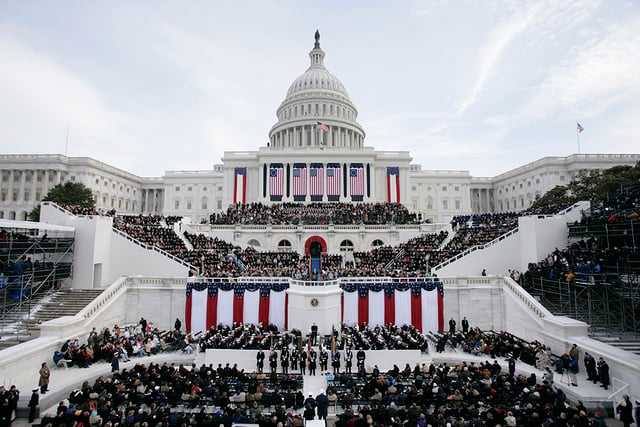It is an odd juxtaposition of administrations – non-consecutive presidential terms being a rarity. As the Biden administration exits and the second Trump presidency begins, it is useful to look back – not at the single Biden term, but at the four preceding sets of policy.
The Biden disasters were the repeat of the 8-year Obama administration in which Biden served. Three terms, then, were predicated on a single, utopian and very mistaken belief that everyone seeks an American-style end-game of peace, security, and prosperity. And the corollary belief that it can be bought.
They don’t. And we can’t.
The Obama/Biden years of coddling and paying off Iran, including the JCPOA, the ouster of the Libyan and Egyptian governments – both of which, although problematic, were allies against mullah regime. There were declining defense budgets that left our soldiers without what they needed; deliberate aggravation of Israel; failure to respond to the use of chemical weapons in Syria or Chinese inroads into the American defense industry; the arming and training of Syrian militias who were part of ISIS; the Benghazi murder of an American diplomat and American service personnel; and the slowest revival from a recession in US history.
After a break for the first Trump administration, Biden picked up where Obama left off.
His foreign disasters, include Afghanistan, wars in the Middle East and Ukraine, replenishment of Iran’s bank accounts and its subsequent expenditures on terror partners Hezbollah, Hamas, PIJ and the Houthis. They are the result of armies, governments, and terror organizations that prize ideology, money and physical control. Domestic disasters including inflation, crime, an open southern border leading to child exploitation and more crime, and infrastructure decline come from the same determination of bad guys to be rich and dominant.
Following the hasty, ill-advised, bloody, expensive abandonment of Afghanistan, the Taliban promised to behave. That promise led to the US providing a terror organization with approximately $2.1 billion in “humanitarian funding” since 2001. In return, the Taliban outlawed education for Afghan women, outlawed Afghan women’s voices in the streets, and outlawed windows to ensure those voices were not heard. According to the World Food Program, the economy is in near collapse and one in three Afghans suffers from hunger.
The Palestinian Authority (PA) also promised to behave. But it didn’t. And despite the bipartisan Taylor Force Act, which bans US funds to the PA as long as it supports “pay for slay,” the administration brags that it spend over $600 million in economic support for the PA in its first two years, with “$230 million in additional funding to support economic recovery and development programs in the West Bank and Gaza… in addition to the over $1.2 billion in humanitarian assistance since October 7, 2023.”
What happened in between? The Trump administration left its mark:
It was the first administration since Dwight D. Eisenhower not to engage the US in a foreign war or new foreign peacekeeping. The Abraham Accords have no promise of American money or troops as “monitors.”
The Abraham Accords abandoned the requirement that Israel take “risks for peace.” It was predicated on the notion of Israel and willing Arab states (and Palestinians, if they chose) prioritize the economic and security needs of their people and it was a success. The US abandoned the untenable position of “neutral party” between Israel and the PA, and took the role of honest broker. US-Israel security cooperation, grounded in commonality, continued through the pandemic.
The US withdrew from the JCPOA with its legal pathway for Iran to achieve nuclear weapons capability even if it hadn’t cheated, The dispatch of Qassem Soleimani, restoration of sanctions on Iran with a strong path for humanitarian aid for the people, and the determination to help Iraq assert its independence from Iran were all important.
NATO accepted the challenge of defending itself, and the members increased spending on their own defense as well as redistributing the financial burden.
The US Defense Budget, which had declined precipitously under the years of crippling “sequestration” in the Obama administration, focused on restoration of a ready force to be followed by increased R&D for future battles.
Throw in pre-COVID economic growth – including the lowest Black and Latino unemployment since those statistics have been kept – and major economic growth beginning in the second and third quarters of 2020 as people learned to navigate the pandemic; a US-Mexico-Canada (USMCA) trade agreement; reductions in illegal immigration and a concerted surge of investigations and arrests against sex and drug trafficking in the United States and beyond – with emphasis on sex-trafficking, which often ensnares minor children.
Tax cuts and the rise in the stock market meant a lot, not only to “millionaires and billionaires,” but to Americans investing their college and retirement funds – which is most of us. Much of the stock market surge was attributable to federal government deregulation and the rise in energy independence made possible by “fracking.” More than half of Americans said they were “better off” in 2020 than four years earlier – COVID-19 notwithstanding.
Now Trump is back.
After eight years down (2009-2016), four years up (2017-2020), and four down (2021-2024), we appear to have a blueprint for the next four.


